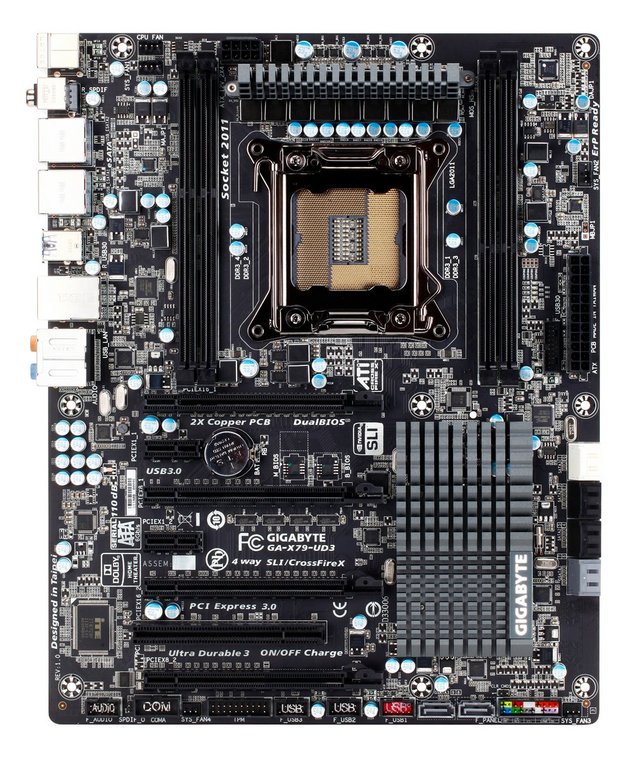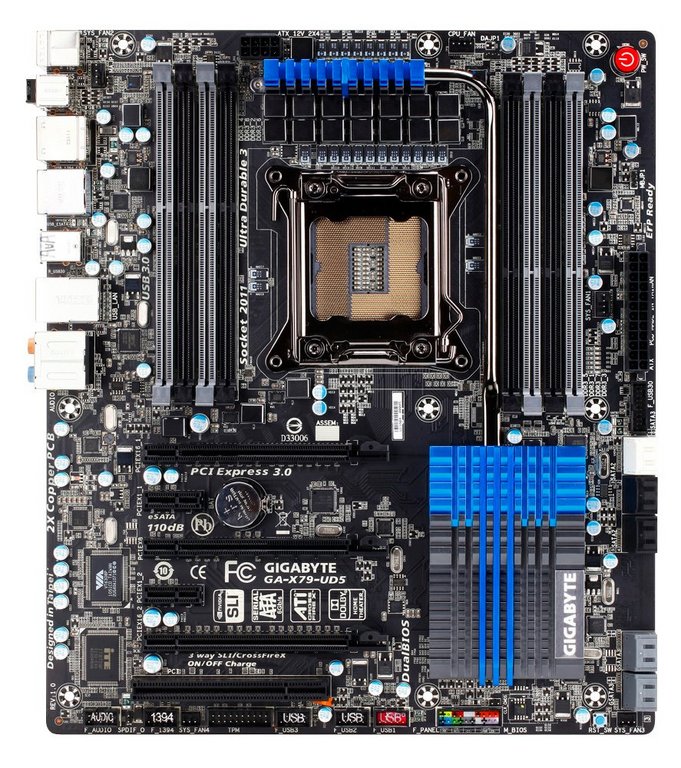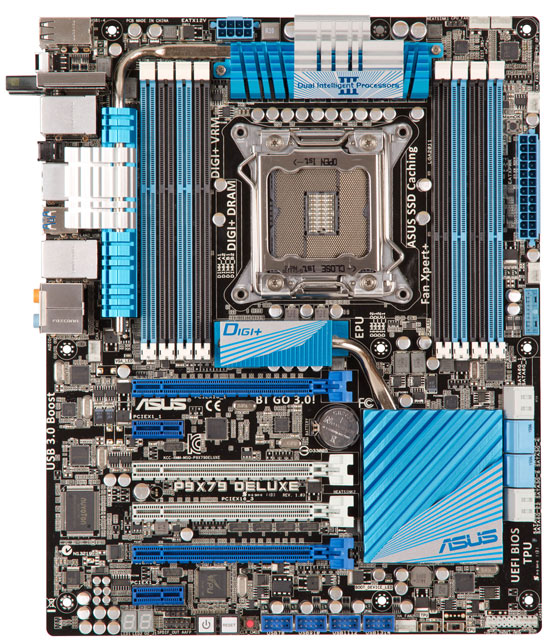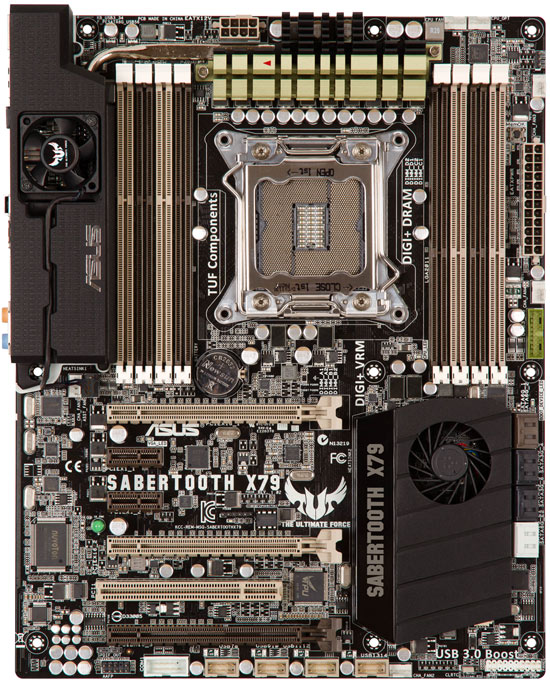More X79 Motherboards Revealed by Manufacturers
With the pending release of the Intel X79 Sandy Bridge-E platform slated for November, manufacturers have begun readying their motherboards and here is a sneak peak of a few.
Recently, we shared with you a sneak peek of the Asus’ ROG (Republic of Gamers) Rampage IV Extreme and eVGA X79 E779 Classified motherboards. Today, we share a sneak peek of some of the other upcoming Intel X79 motherboards.
- Gigabyte GA-X79-UD3
- Gigabyte GA-X79-UD5
- Asus P9X79 Deluxe
- Asus TUF Sabertooth X79
- eVGA X79 FTW
Gigabyte GA-X79-UD3: Has four DDR3 DIMM slots, four PCI-Express 3.0 x16 (two capable of x16,x16) and two PCI-Express 2.0 x1 expansion slot. There two SATA 6 Gb/s (white), four SATA 3 Gb/s (black) from the Intel X79 controller and four SATA 6 Gb/s (gray) from a Marvell controller. The I/O panel comes with the standard variation of USB 3.0 and USB 2.0 ports, along with 8+2 channel HD audio and Gigabit LAN connection.
Gigabyte GA-X79-UD5: Has eight DDR3 DIMM slots, three PCI-Express 3.0 x16 (two capable of x16,x16), two PCI-Express 2.0 x1 and one PCI expansion slot. There are two SATA 6 Gb/s (white), four SATA 3 Gb/s (black) from the Intel X79 controllers and four SATA 6 Gb/s (gray) from a Marvell controller. The I/O panel comes with the standard variation of USB 3.0 and USB 2.0 ports, along with 8+2 channel HD audio and Gigabit LAN connection.
Asus P9X79 Deluxe: Has eight DDR3 DIMM slots, four PCI-Express x16 (unclear if they are PCI-Express 3.0 or a combination of 3.0 & 2.0) and two PCI-Express 2.0 x1 expansion slot. There are eight internal SATA ports, including two SATA 6 Gb/s (gray), four SATA 3 Gb/s (blue) from the Intel X79 controller and two SATA 6 Gb/s (white) from a Marvell controller. The I/O panel comes with the standard variation of USB 3.0 and USB 2.0 ports, along with 8+2 channel HD audio and two Gigabit LAN connections.
Asus TUF Sabertooth X79: Has eight DDR3 DIMM slots, two PCI-Express 3.0 x16 (capable of x16,x16), one PCI-Express 2.0 x16 (@ x8), two PCI-Express 2.0 x1, and one PCI expansion slot. There are eight internal SATA ports, including two SATA 6 Gb/s (brown), four SATA 3 Gb/s (black) from the Intel X79 controller and two SATA 6 Gb/s (white) from a third-party controller. The I/O panel comes with the standard variation of USB 3.0 and USB 2.0 ports, along with 8+2 channel HD audio and Gigabit LAN connection.
eVGA X79 FTW: Has four DDR3 DIMM slots, four PCI-Express 3.0 x16 (two capable of x16,x16), one PCI-Express 2.0 x16 (@ x8) and one PCI-Express 2.0 x1 expansion slot. There are only six internal SATA ports, including two SATA 6 Gb/s (red) and four SATA 3 Gb/s (black) from the Intel X79 controller. The I/O panel comes with the standard variation of USB 3.0 and USB 2.0 ports, along with 8+2 channel HD audio and two Gigabit LAN connections to list just a few of the options.
Get Tom's Hardware's best news and in-depth reviews, straight to your inbox.
-
de5_Roy the motherboards look great (and expensive) especially the asus tuf sabretooth. now wait for the cpus to release...Reply
is it me or the atx form factor is too small for x79? :) -
paperfox Interesting how the ram slots are now divided evenly on each side of the cpu socket. That could be a problem as some coolers block the first memory slot, and now they will block two.Reply -
LuckyDucky7 Yay! New P67/Z68 boards with quad-channel memory tacked on!Reply
Because there's nothing new here, folks. It should really just be called X68 because there's nothing new in the chipset other than a lot of pins.
I mean:
-No native USB 3.0 ports
-No replacement for USB 3.0 ports (Light Peak/Thunderbolt) in sight
-Not enough native SATA 6GB/s ports (there are TWO).
And the only real reason to buy a board like this is with a processor that costs 600+ dollars (existence of the i7-3820 is completely redundant due to the i7-2700K, which performs no better in games than the i5-2500K does).
It's not actually a real enthusiast platform.
If it were, it would have the features above.
It's just priced that way, because it can be. -
warmon6 LuckyDucky7Yay! New P67/Z68 boards with quad-channel memory tacked on!Because there's nothing new here, folks. It should really just be called X68 because there's nothing new in the chipset other than a lot of pins.I mean:-No native USB 3.0 ports-No replacement for USB 3.0 ports (Light Peak/Thunderbolt) in sight-Not enough native SATA 6GB/s ports (there are TWO).And the only real reason to buy a board like this is with a processor that costs 600+ dollars (existence of the i7-3820 is completely redundant due to the i7-2700K, which performs no better in games than the i5-2500K does).It's not actually a real enthusiast platform. If it were, it would have the features above.It's just priced that way, because it can be.Reply
If your buying these types of motherboards... your propably not looking for gaming unless your looking at tri or 4-way gpu setup.....
Mainly these board will be used for stuff that's memory limited or memory bandwidth limited such as rendering.
Look beyond the gaming world ;) -
zanny Like Bulldozer, this is more of a cheapo server than a gaming platform. As long as the current console generation lingers on, nobody is pushing any boundaries in terms of hardware, except for video cards. You could still be playing on an old core 2 duo and in 99% of games see no performance difference between that and one of these chips, just because well designed games use almost no cpu time and do every computation on the gpu.Reply
Likewise, good games dont use almost any ram, because all the textures / models / etc are on the gpu. All you have on the cpu is the games internal representation of the game world and all the settings for the game to operate on.
So you dont need more than 4gb of ram, with pretty wide frequency yields, you dont need more than a dual core cpu (because all the parallel work is being done gpu side anyway) just so the OS is running on one core and the game runs uninterrupted on the other.
The bottlenecks always reduce to the gpu doing more complex rendering math and the hard drive loading textures (and with sufficient video memory, you just load every texture before you even use it and the hard drive latency becomes irrelevant except at start up of the game). So you just want an SSD for start up time and first load times and the best gpu you can get to paint sparkly lights.
So gaming platform wise, none of these recent releases mean dirt. Nothing has for a while, except graphics cards. We oversell the processor and ram and undersell the gpu - its always worth it to go from a 570 to a 580 and trade in the i7 for an i5 and the 12 gigs ram for 4 gigs. The main system really doesnt matter anymore, its that giant hunk of independent computer doing all the rendering that is important now.
Servers though, especially for the web, will be all over this. 16 - 32 gb system ram + 8 threads to run at 4.5 - 5 ghz is enough to host a pretty popular web site for a hella lot less than a server rack. You could easily handle a butt load of web framework page generation on a system built in a traditional case now, and that is where these platforms have their place to shine - highly parallel web frameworks that need all the pages in ram to build html css and javascript to ship to a fewer as fast as possible. -
stingstang If by 'enthusiast' you mean the people who will upgrade after every refresh, then yes, these are enthusiast parts. Sensible people like myself will stick with what we have. ^.^ Not worth setting back my C7 Corvette ownership date.Reply -
zanny As a footnote though, going forward, those web servers are drooling to start utilizing stream processors. Doing parallel page construction is a hard but doable problem, and it makes non parallel machines practically worthless. Its a viable idea to have one of these systems with some workstation graphics to do anything parallel you can pull off in openCL, but looking forward expect the web server of 2015 to just be truckloads of ram and truckloads of processor cores with an SSD the size of ram just for whenever the system gets rebooted (obviously have a backup power supply to provide uninterrupted access).Reply




